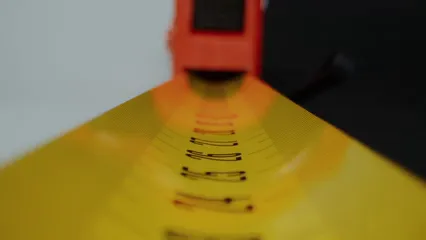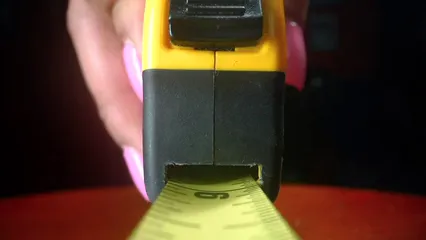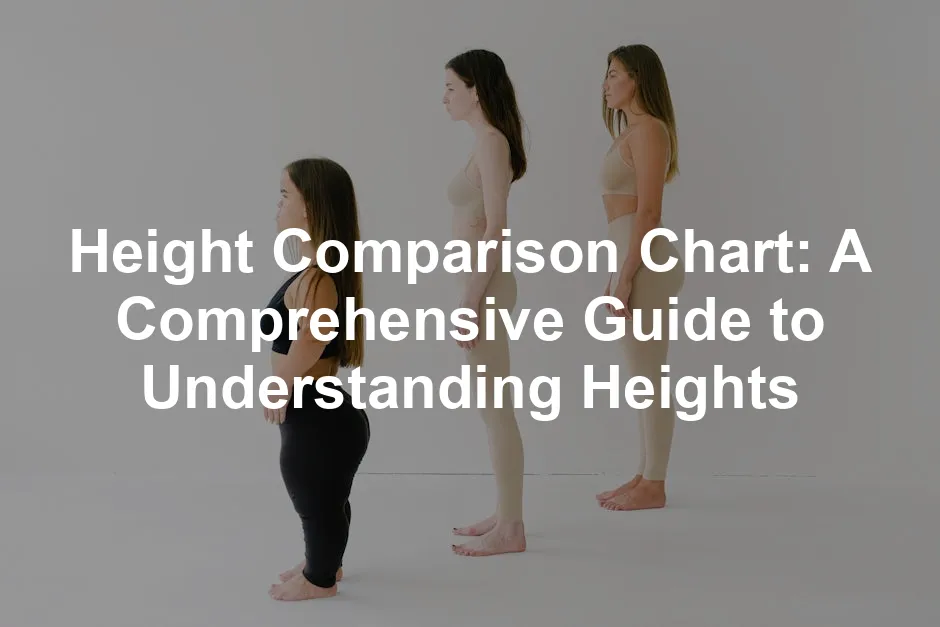Introduction
In a world where height can influence everything from fashion choices to dating preferences, a height comparison chart is more relevant than ever. Whether you’re trying to visualize how you stack up against a friend, comparing your height with that of your favorite celebrity, or planning a wedding with an eye toward bridal party proportions, understanding height differences can be both fun and informative.
Ever stood next to someone and wondered, “Am I really that short?” Or maybe you’ve thought, “How do I measure up to my favorite superhero?” A height comparison chart can help answer those burning questions. These charts are not just for the curious; they can be essential tools in various scenarios.
For instance, if you’re a designer contemplating how furniture fits into a room, a height comparison chart can help visualize that couch next to your 6’2” friend. Or perhaps you’re planning a bridal party and want everyone to look picture-perfect? You guessed it—height charts can guide those decisions too!
Let’s not forget the entertainment value. Comparing your height to that of athletes or movie stars can be downright amusing. Who doesn’t love a little friendly rivalry? Plus, it’s a fantastic conversation starter at parties. “Did you know I’m taller than Tom Cruise?” Talk about a surprising twist!

Speaking of measuring, why not make it easy with a measuring tape? It’s perfect for measuring your height or that of your friends—no more guesswork!
In this article, we’ll dive into the world of height comparison charts, exploring how they work, their various applications, and why they can be an essential tool for anyone interested in measuring up—literally! Height comparison charts are not just a quirky novelty; they carry significant weight in our social interactions and personal decisions.
So, let’s lace up our measuring tapes and get started!
Summary
This article will explore the many facets of height comparison charts, answering questions such as what they are, how to use them effectively, and their various applications. We’ll discuss the differences between measuring people and objects, the psychological aspects of height perception, and provide examples of how height comparisons can influence our social interactions. By the end of this article, you’ll not only understand how to use a height comparison chart but also appreciate its significance in both everyday life and specialized fields.
We’ll cover everything from home remodeling to fun comparisons with fictional characters, ensuring that you leave with a well-rounded understanding of this fascinating tool. Height comparison charts are not just for measuring; they’re about connecting with others, making informed decisions, and having a little fun along the way. So whether you’re a curious individual or a professional in need of precise measurements, this article aims to equip you with all the knowledge you need to measure up!
Get ready to see how height can shape your world, one comparison at a time!

What is a Height Comparison Chart?
A height comparison chart is a visual tool designed to illustrate the height differences between various subjects, be it people, objects, or fictional characters. The primary purpose is to simplify the understanding of how tall or short someone or something is relative to another.
These charts can be interactive, allowing users to input heights and see immediate results. This interactivity enhances engagement, making it more enjoyable to visualize height differences.
There are several types of comparisons that can be made. You can compare individuals, such as friends or family members, and see who stands taller at a glance. Alternatively, you can measure your height against iconic objects, like the Eiffel Tower or even a school bus. And let’s not forget about the fun factor—comparing your height to that of beloved fictional characters can spark joy and laughter.
Most height comparison charts use common measurement systems like feet and inches or centimeters. If you’re unsure about conversions, many online tools can do the math for you. Understanding these measurements can enhance your experience, allowing for accurate comparisons regardless of the units used.
In summary, height comparison charts are versatile tools that serve both practical and entertainment purposes. They help visualize our place in the world, whether standing next to a friend or gazing up at a towering landmark. So, whether you’re a curious mind or a meticulous planner, this tool is here to help you measure up!

How to Use a Height Comparison Chart
Using a height comparison chart can be as easy as pie—if pie were a mathematical equation involving feet, inches, and a sprinkle of fun! So, roll up those sleeves and prepare to measure up with this step-by-step guide.
Step-by-Step Guide
Step 1: Gather Height Data
First things first! You need height data. Accurate measurements are crucial. After all, nobody wants to tell a fib about their height! Use a trusty ruler set to get your own height. For others, a quick online search can bring up reliable sources. Just type in “average height of [insert name or category],” and voilà, you’ll have the info you need. Remember, accuracy is key here—no one wants to be the friend who claims to be 6’2″ but is really 5’10”.

Step 2: Inputting Data
Now, it’s time to enter your gathered data into a height comparison tool. Most tools are user-friendly. Start by selecting the gender of those involved—after all, it’s essential for accurate comparisons. Then, type in the names of the people or objects you’re comparing. Finally, input their respective heights in your preferred measurement units: feet and inches or centimeters. Make sure to double-check those numbers. Trust us; a misplaced decimal can lead to some awkward comparisons!

Step 3: Visual Representation
Once you’ve entered all the data, hit that “compare” button! The tool will generate a visual output. This is where the magic happens! Silhouettes will appear alongside each other, showcasing who’s taller and by how much. Many tools even allow you to customize these silhouettes. Want to make your avatar wear a funky hat? Go for it! Customization adds a personal touch and makes the experience way more enjoyable.

Best Practices
Ensuring Accuracy
To achieve the most reliable results, always use precise measurements. Avoid rounding off heights unless necessary. Also, try to use the same measurement unit throughout to prevent confusion. If you’re comparing multiple people, ensure everyone’s heights are collected under similar conditions—standing straight, shoes off, and on a flat surface.

Common Mistakes
Many users fall into the trap of mixing measurement systems. One minute you’re all set with feet, and the next, you’ve accidentally switched to centimeters. This leads to some pretty ridiculous results. Another common mistake is assuming heights without checking. Don’t be that person who confidently compares their height to a celebrity without verifying their actual height first. Trust but verify, friends!

In summary, using a height comparison chart is a straightforward process, but it’s essential to be accurate and consistent to get the best results. Whether you’re planning an event, redecorating, or just having fun, these charts are a handy tool to visualize height differences and make informed decisions. Now, let’s get measuring!

Fun Comparisons
Who hasn’t measured themselves against a celebrity? It’s practically a rite of passage! We all love to imagine how we stack up against our favorite stars. Whether it’s thinking, “I’m taller than Tom Cruise!” or “I’m just a few inches shorter than Gal Gadot,” these comparisons add a sprinkle of fun to our day.
But it’s not just celebrities! Fictional characters also play a huge role in height comparisons. Who hasn’t wondered how they measure up to superheroes? Picture yourself standing next to Spider-Man or even Shrek—imagine the height difference! These playful comparisons can help us connect with our favorite characters in a unique way. Plus, they can spark some lively conversations. “Did you know I could almost be a hobbit?”

Height comparison charts also allow fans to visualize their all-time favorite characters. Characters from movies, anime, or comics can easily be compared to each other, adding depth to their stories. Visualizing these differences not only entertains but also enhances fandom experiences. So next time you’re curious about how you measure up, grab a height comparison chart and find the answers!

Educational Uses
Height comparisons can be surprisingly educational! Teachers often use these tools to teach measurement concepts effectively. For instance, kids can learn about height, length, and even proportions through fun activities.
By comparing different heights, students grasp the ideas of measurement and scale. Imagine a lesson where students measure their heights and then compare them to classroom objects. Suddenly, that ordinary pencil isn’t just a pencil; it becomes a towering giant when measured against a 5-year-old!

This hands-on approach not only makes learning engaging but also fosters teamwork. Students can work in pairs, measuring each other while discussing their findings. The excitement of seeing their classmates’ heights next to familiar objects can ignite curiosity and make a lasting impression.
Incorporating height comparisons into lessons can also spark conversations about personal growth and development. Students may discuss how their heights might change over the years. This simple yet fun activity encourages learning about measurement while boosting confidence among peers. Learning has never been this entertaining!

If you’re looking to add some creativity to the learning process, consider using kids’ educational measurement toys. They make learning about measurements fun and engaging!
Conclusion
In conclusion, height comparison charts are not just quirky tools; they make our lives easier and more entertaining. Whether you’re remodeling your home or engaging in a friendly debate about who’s taller—Tom Cruise or you—these charts serve a multitude of purposes. They help visualize height differences, making it simpler to plan spaces or events. Imagine organizing a wedding party and wanting everyone to look their best. A height comparison chart can guide you in selecting the perfect arrangements to ensure all your friends stand out—literally!

But it doesn’t stop there! These charts also offer a fun way to compare yourself with your favorite celebrities or fictional characters. Ever wondered how you measure up to your favorite superhero? Using a height comparison chart can provide a clear visualization that’s more rewarding than just guessing. You might find you’re taller than you expected—or perhaps not. Either way, it adds an element of joy to our everyday interactions.
So, the next time you find yourself asking, “How do I stack up?” reach for a height comparison chart. Whether you’re looking to settle a debate, plan your living space, or just have a laugh with friends, this tool is incredibly versatile. Get ready to embrace the fun and functionality of height comparisons. They’re not just for the curious; they’re for anyone wanting to measure up in life—literally and figuratively!
FAQs
What is a height comparison chart?
A height comparison chart is a visual tool that illustrates the height differences between various subjects, including people and objects. It simplifies understanding how tall or short someone or something is relative to another. These charts can be interactive, allowing users to input heights and instantly see comparisons.
How can I create a height comparison chart?
Creating a height comparison chart is a straightforward process. First, gather the height data of the subjects you want to compare. You can use a quick Google search for accurate measurements. Next, input the data into an online height comparison tool, where you can customize options like gender and measurement units. Finally, hit ‘compare’ and enjoy the visual representation of your findings!
Can I compare objects and people?
Absolutely! Many height comparison tools allow you to compare both people and objects. This versatility makes it easy to see how you measure up not just against friends, family, or celebrities, but also against iconic structures like the Eiffel Tower or everyday items like a car.
What measurement units are available?
Height comparison tools typically offer various measurement units, including feet, inches, and centimeters. Most tools automatically convert measurements, so you can easily visualize heights regardless of the units you prefer.
Is there a limit to how many comparisons I can make?
Different height comparison tools may have varying limits on the number of comparisons. Some allow you to compare multiple subjects at once, while others might limit you to two or three. It’s always best to check the specific tool for its limits and capabilities.
Height comparison charts are useful tools that can be applied in various contexts, including educational settings. height comparison chart can enhance learning by making measurement concepts engaging.
If you’re looking for a fun and interactive way to keep track of your kids’ growth, consider a Height Growth Chart for Kids. It’s a wonderful way to celebrate their milestones while making measurement fun!
Please let us know what you think about our content by leaving a comment down below!
Thank you for reading till here 🙂
All images from Pexels




